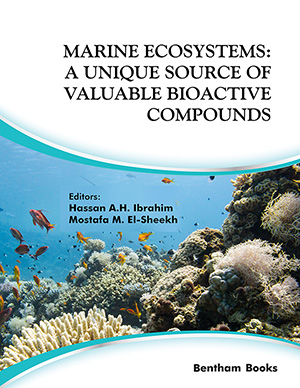Abstract
Of the several types of aquatic ecosystems, marine ecosystems are the
largest and are characterised by high salt concentrations. Therefore, aquatic flora, fauna
and microbes which are highly halophilic can be found here abundantly. Apart from
oceans and seas, there are various other types of marine habitats like salt marshes,
estuaries, intertidal areas, coral reefs, lagoons and mangroves . Bioactive compounds
are those chemicals produced typically in small quantities by plants, animals or
microbes for their own protection or functioning, but have beneficial effects on human
health. Since marine ecosystems are exceptionally rich in biodiversity, the prospect of
availability of the bountiful bioactive agents can easily be conjectured. Primary
producers like microalgae and phytoplanktons are rich sources of various pigments like
carotenoids, beta-carotene and polyunsaturated aldehyde. Sea-weeds are abundant in
vitamins A and C, and also in phenolic compounds, terpenes, etc. Primary consumers
like crustaceans and molluscs are reported to produce steroids having high medicinal
potential. Carnivorous fishes like herring, shad and mackerel are the secondary
consumers. Mackerel is a great source of the amino acid taurine, which is considered to
have beneficial effects on heart health. Top carnivorous fishes like the haddock or cod
belong to the category of tertiary consumers. Cod is popular for its “cod-liver oil”
which has high contents of vitamins A, D and E and omega-3-fatty acids whose health
benefits are familiar to all. Even the decomposers like marine bacteria and fungi are
effective manufacturers of alkaloids, terpenes, peptides and mixed biosynthetic
compounds derived from polyketides. Thus, it will not be an exaggeration to say that
the marine ecosystem has a plethora of bioactive compounds, and it can easily be
proclaimed that collective efforts in the form of copious research and documentation
are required to enable sustainable utilisation of this untapped bioresource. This review
is presented here as a small step to reach that goal.
Keywords: Bioactives, Marine Ecosystem, Bioresource, Phytochemicals, Toxins.






















